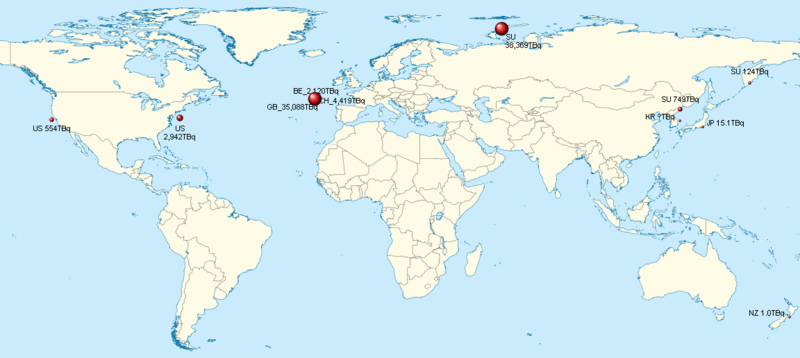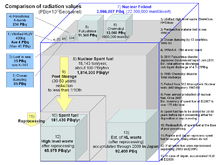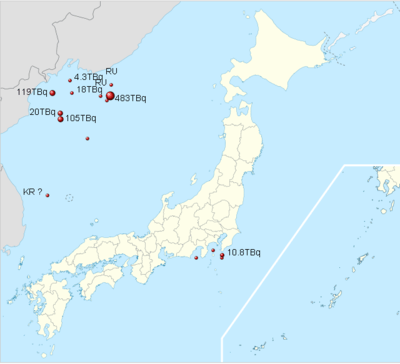Ocean disposal of radioactive waste
From 1946 through 1993, thirteen countries (fourteen, if the USSR and Russia are considered separately) used ocean disposal or ocean dumping as a method to dispose of nuclear/radioactive waste. The waste materials included both liquids and solids housed in various containers, as well as reactor vessels, with and without spent or damaged nuclear fuel.[1] Since 1993, ocean disposal has been banned by international treaties. (London Convention (1972), Basel Convention, MARPOL 73/78)
However, according to the United Nations, some companies have been dumping radioactive waste and other hazardous materials into the coastal waters of Somalia, taking advantage of the fact that the country had no functioning government from the early 1990s onwards. According to one official at the United Nations, this caused health problems for locals in the coastal region and posed a significant danger to Somalia's fishing industry and local marine life.[2]
"Ocean floor disposal" (or sub-seabed disposal)—a more deliberate method of delivering radioactive waste to the ocean floor and depositing it into the seabed—was studied by the UK and Sweden, but never implemented.[3]
History
Data are from IAEA-TECDOC-1105.[1] page 3-4
- 1946 First dumping operation at Northeast Pacific Ocean (about 80 km off the coast of California)
- 1957 First IAEA Advisory Group Meeting on Radioactive Waste Disposal into the Sea
- 1958 First United Nations Conference on the Law of the Sea (UNCLOS I)
- 1972 Adoption of the Convention on the Prevention of Marine Pollution by Dumping of Wastes and Other Matter (London Convention 1972)
- 1975 The London Convention 1972 entered into force (Prohibition of dumping of high level radioactive waste.)
- 1983 Moratorium on low-level waste dumping
- 1988 Assessing the Impact of Deep Sea Disposal of Low-level Radioactive Waste on Living Marine Resources. IAEA Technical Reports Series No. 288
- 1990 Estimation of Radiation Risks at Low Dose. IAEA-TECDOC-557
- 1993 Russia reported the dumping of high level nuclear waste including spent fuel by former USSR.
- 1994 Feb-20 Total prohibition of disposal at sea came into force
1946-93
Data are from IAEA-TECDOC-1105.[1] Summary of pages 27–120
Disposal projects attempted to locate ideal dumping sites based on depth, stability and currents, and to treat, solidify and contain the waste. However, some dumping only involved diluting the waste with surface water, or used containers that imploded at depth. Even containers that survived the pressure could physically decay over time.

The countries involved — listed in order of total contributions measured in TBq (TBq=1012 Becquerel) — were the USSR, the UK, Switzerland, the US, Belgium, France, the Netherlands, Japan, Sweden, Russia, New Zealand, Germany, Italy and South Korea. Together, they dumped a total of 85,100 TBq (85.1x1015Bq) of radioactive waste at over 100 ocean sites, as measured in initial radioactivity at the time of dump.
For comparison:

- Global fallout of nuclear weapon tests — 2,566,087x1015Bq.[4]
- 1986 Chernobyl disaster total release — 12,060x1015Bq.[5]
- 2011 Fukushima Daiichi nuclear disaster, estimated total aerial release — 11,346x1015Bq.[6]
- Fukishima Daiichi nuclear plant cooling water dumped (leaked) to the sea — TEPCO estimate 4.7x1015Bq, Japanese Nuclear Safety Commission estimate 15x1015Bq,[7] French Nuclear Safety Committee estimate 27x1015Bq.[8]
- Naturally occurring Potassium 40 in all oceans — 14,000,000x1015Bq.[9]
- One container (net 400kg) of vitrified high-level radioactive waste has an average radioactivity of 4x1015Bq (Max 45x1015Bq).
| Country | dumped (unit TBq=1012Bq) | period | num of sites, volume, etc.* | |||
|---|---|---|---|---|---|---|
| Arctic | Atlantic | Pacific | Total | |||
| | 38,369 | 0 | 874 | 39,243 | 1959-92[10] | Arctic ; 20 sites, 222x103m3 and reactor w or w/o spent fuel, Pacific Ocean (mainly sea of Japan); 12 sites, 145x103m3 |
| | 0.7 | 0 | 2.1 | 2.8 | 1992-93 | Arctic ; 3,066m3, Pacific Ocean 6,327m3 |
| | 0 | 2,120 | 0 | 2,120 | 1960-82 | NE Atlantic 6 sites, 55,324 containers, 23.1x103tons |
| | 0 | 354 | 0 | 354 | 1967-69 | NE Atlantic 2 sites, 46,396 containers, 14.3x103tons |
| | 0 | 0.2 | 0 | 0.2 | 1967 | NE Atlantic 1 site once, 480 containers, 185tons |
| | 0 | 0.2 | 0 | 0.2 | 1969 | NE Atlantic 1 site, 100 containers, 45tons |
| | 0 | 336 | 0 | 336 | 1967-82 | NE Atlantic 4 sites, 28,428 containers, 19.2x103tons |
| | 0 | 3.2 | 0 | 3.2 | 1959,61,69 | Baltic sea 1 site, 230 containers, 64 tons, NE Atlantic 1 site, 289.5 containers, 1,080 tons, |
| | 0 | 4,419 | 0 | 4,419 | 1969-82 | NE Atlantic, 3 sites, 7,420 containers, 5,321 tons |
| | 0 | 35,088 | 0 | 35,088 | 1948-82 | NE Atlantic 15 sites, ?? containers, 74,052 tons and 18 sites off coast of British isles more than 9.4 TBq |
| | 0 | 2,942 | 554 | 3,496 | 1946-70 | Mid/NW of Atlantic (9), Gulf of Mexico (2) total 11 sites, 34,282 containers, ? tones, Mid/NE of Pacific Ocean, total of 18 sites, 56,261 containers, ? tones |
| | 0 | 0 | 15.08 | 15.08 | 1955-69 | South of main island, 6 sites 15 times, 3,031 containers, 606x103m3 |
| | 0 | 0 | 1.04 | 1.04 | 1954-76 | East coast of New Zealand, 4 sites, 9 containers, 0.62m3 |
| | 0 | 0 | no data | 1968-72 | Sea of Japan, 1 site 5 times?, 115 container, 45 tons | |
| Total | 38,369 | 45,262 | 1,446 | 85,077 | Subtotal of all volume reported is 982,394m3. | |
| *Some countries report the mass and volume of disposed waste and some just tonnage. The US did not report tonnage or volume of 90,543 containers. | ||||||
Types of waste and packaging
Data are from IAEA-TECDOC-1105.[1]:6–7, 14
Liquid waste
- unpackaged and diluted in surface waters
- contained in package but not solidified
Solid waste
- low level waste like resins, filters, material used for decontamination processes, etc., solidified with cement or bitumen and packaged in metal containers
- unpackaged solid waste, mainly large parts of nuclear installations (steam generators, pumps, lids of reactor pressure vessels, etc.
Reactor vessels
- without nuclear fuel
- containing damaged spent nuclear fuel solidified with polymer agent
- special container with damaged spent nuclear fuel (icebreaker Lenin by the former Soviet Union)
| Waste type | Atlantic | Pacific Ocean | Arctic | total | note |
|---|---|---|---|---|---|
| Reactors with spent fuel | Nil | Nil | 36,876 | 36,876 | |
| Reactors w/o fuel | 1,221 | 166 | 143 | 1,530 | |
| Low Level solid | 44,043 | 821 | 585 | 45,449 | |
| Low level liquid | <0.001 | 459 | 765 | 1,223 | |
| Total | 45,264 | 1445 | 38,369 | 85,078 |
Dump sites
Data are from IAEA-TECDOC-1105.[1]:27–120
Arctic
Mainly at the east coast of Novaya Zemlya at Kara Sea and relatively small proportion at Barentz Sea by USSR. Dumped at 20 sites from 1959–92,[10] total of 222x103m3 including reactors and spent fuel.

North Atlantic
Dumping occurred from 1948 to 1982. 78% of dumping in the Atlantic was done by UK (35,088TBq), followed by Switzerland (4,419TBq), USA (2,924TBq) and Belgium (2,120TBq). Sunken USSR nuclear submarines are not included. see List of sunken nuclear submarines
137x103tonnes were dumped by 8 European countries. USA reported neither tonnage nor volume for 34,282 containers.

Pacific Ocean
USSR 874TBq, USA 554 TBq, Japan 15.1TBq, New Zealand 1+TBq and unknown amount by South Korea. 751x103m3 were dumped by Japan and USSR. USA reported neither tonnage nor volume of 56,261 containers.
Dumping of contaminated water at 2011 Fukushima Nuclear accident (estimate 4,700-270,00TBq) is not included.

East Sea
USSR dumped 749TBq in the Sea of Japan, Japan dumped 15.1TBq south of main island. South Korea dumped 45 tonnes (unknown radioactivity value) in the Sea of Japan.

Environmental impact
Data are from IAEA-TECDOC-1105.[1]:7
Arctic Ocean
Joint Russian-Norwegian expeditions (1992–94) collected samples from four dump sites. At immediate vicinity of waste containers, elevated levels of radionuclide were found, but had not contaminated the surrounding area.
North-East Atlantic Ocean
Dumping was undertaken by UK, Switzerland, Belgium, France, the Netherlands, Sweden, Germany and Italy. IAEA had been studying since 1977. In the report of 1996 by CRESP suggests measurable leakages of radioactive material but concluded that environmental impact is negligible.
North-East Pacific Ocean, North-West Atlantic Ocean dump sites of USA
These sites are monitored by the United States Environmental Protection Agency and US National Oceanic and Atmospheric Administration. So far, no excess level of radionuclides was found in samples (sea water, sediments) collected in the area, except the sample taken at a location close to disposed packages that contained elevated levels of isotopes of caesium and plutonium.
North-West Pacific Ocean dump sites of USSR, Japan, Russia and Korea
The joint Japanese-Korean-Russian expedition (1994–95) concluded that contamination resulted mainly from global fallout.
See also
References
- 1 2 3 4 5 6 IAEA TECDOC-1105 “Inventory of radioactive waste disposals at sea” August 1999 retrieved 2011-12-4
- ↑ "BBC NEWS - Africa - Waves 'brought waste to Somalia'". bbc.co.uk.
- ↑ World Nuclear Association “Storage and Disposal Options” retrieved 2011-11-14
- ↑ UNSCEAR "Exposures of the public and workers from various sources of radiation"
- ↑ UNSCEAR "Health effects due to radiation from the Chernobyl accident"
- ↑ JA Ministry of Economy, Trade and Industry "Estimate of aerial release of radioactive nucleides" retrieved 2012-02-20
- ↑ Japan Atomic Industrial Forum Inc(JAIF) “Earthquake-report 250 (30 October 2011)” retrieved 2011-11-12
- ↑ Mainichi Shimbun "Cesium-137 flow into sea 30 times greater than stated by TEPCO report (29 October 2011)" retrieved 2011-11-12
- ↑ Idaho State University "Radiation Information Network's Radioactivity in Nature"
- 1 2 Although USSR dissolved on E/1991, IAEA reported dumping of USSR in 1992.
